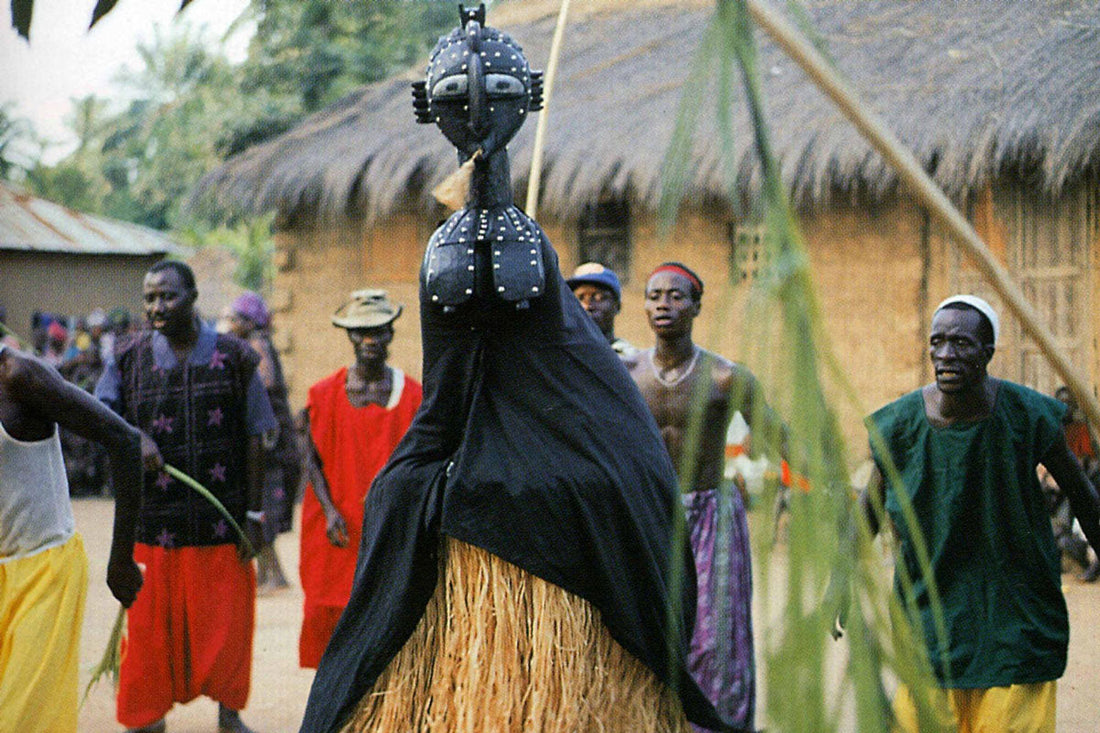
The Baga People of Guinea: History, Culture, and the Iconic Nimba Mask
Share
The Baga people of Guinea, West Africa, are renowned for their rich cultural heritage and striking artistic traditions, particularly their ceremonial masks and sculptures. Among their most celebrated creations is the Nimba shoulder mask, a monumental wooden carving representing fertility, abundance, and feminine power. This blog explores the history and culture of the Baga tribe, their artistic legacy, and the profound symbolism of the Nimba mask—one of the most recognizable female African masks in West African art.
The Baga Tribe: History and Cultural Significance
The Baga people are an ethnic group primarily residing in the coastal regions of Guinea, particularly around the areas of Boké and Boffa. Historically, they lived in decentralized villages organized around rice cultivation, fishing, and trade. Their society was traditionally governed by secret societies, such as the Simo and A-Tekan, which played crucial roles in maintaining social order, spiritual practices, and artistic expression.
The Baga’s cultural identity was deeply intertwined with their environment, as seen in their agricultural rituals and reverence for natural forces. However, their traditions faced significant disruption during colonial rule and the spread of Islam, leading to the decline of some ceremonial practices. Despite these challenges, Baga art, especially their masks and sculptures, remains a vital part of African cultural heritage.

Baga Art: Symbolism and Aesthetic Mastery
Baga art is characterized by its bold, abstract forms and deep spiritual significance. Their sculptures and masks were not merely decorative but served as conduits for ancestral communication, social cohesion, and agricultural blessings. Among their most famous creations are:
-
Nimba (D'mba) mask
-
Bansonyi carved snake
- Timba drum
The Nimba mask, in particular, stands out as a masterpiece of West African art, embodying themes of fertility, prosperity, and feminine energy.
The Nimba Shoulder Mask: A Symbol of Fertility and Abundance
The Nimba mask (also called D’mba) is one of the most iconic female African masks, representing the idealized mother, nurturer, and bringer of life. Carved from a single piece of wood, the mask is worn horizontally on the dancer’s shoulders, towering over the crowd during ceremonies.
Key Features of the Nimba Mask include:
-
Exaggerated Breast and Hairstyle – The mask’s large, rounded breasts symbolize nourishment and fertility, while the intricate coiffure reflects beauty and social status.
-
Pierced Eyes and Prominent Nose – The facial features are abstract yet expressive, emphasizing spiritual presence rather the realism.
- Height and Presence – Standing up to four feet tall, the mask's imposing size commands reverence during performances.

Ritual Significance of the Nimba Mask
The Nimba mask was central to agricultural festivals, particularly those celebrating the rice harvest. As a fertility mask, it invoked the blessings of ancestral spirits to ensure bountiful crops and community prosperity. Dancers wearing the mask performed rhythmic movements, embodying the spirit of Nimba—the divine mother who sustains life.
In Baga cosmology, the mask was not just an object but a living entity, believed to channel the energy of female ancestors. Its use was restricted to initiated members of secret societies, reinforcing its sacred status.
The Influence of Baga Art Beyond Guinea
While the Baga tribe’s traditional practices declined in the 20th century due to external pressures, their art gained international recognition. The Nimba mask, in particular, captivated Western artists and collectors, influencing modernist movements. Its abstract yet powerful form resonated with artists like Pablo Picasso, who drew inspiration from African fertility art in developing Cubism.
Today, Baga masks and sculptures are displayed in major museums worldwide, including: The Metropolitan Museum of Art, Musée du Quai Branly, and Fowler Museum at UCLA.

Preserving Baga Cultural Heritage
Efforts to document and revive Baga traditions are ongoing, with scholars and cultural institutions working to safeguard this legacy. The Nimba mask remains a symbol of resilience, artistic brilliance, and the enduring power of West African art.
The Enduring Legacy of Baga Art and the Nimba Mask
The Baga people of Guinea have left an indelible mark on the world through their extraordinary artistic traditions. The Nimba shoulder mask, with its powerful symbolism of fertility, femininity, and abundance, stands as one of the most iconic examples of West African art. More than just a ceremonial object, the Nimba mask embodies the spiritual and cultural values of the Baga tribe, serving as a bridge between the physical and ancestral realms.
In a modern context, the influence of Baga art extends far beyond Guinea. The striking aesthetics of the Nimba mask have inspired artists, collectors, and scholars, reinforcing the global significance of African artistic traditions. Museums and academic institutions continue to preserve and study these works, ensuring that the legacy of the Baga people remains accessible to future generations.
As we reflect on the Baga mask and its role in African cultural heritage, we are reminded of the profound connections between art, spirituality, and community. The Nimba mask is not merely a relic of the past but a living testament to the creativity and resilience of the Baga people—an enduring symbol of beauty, power, and tradition.
